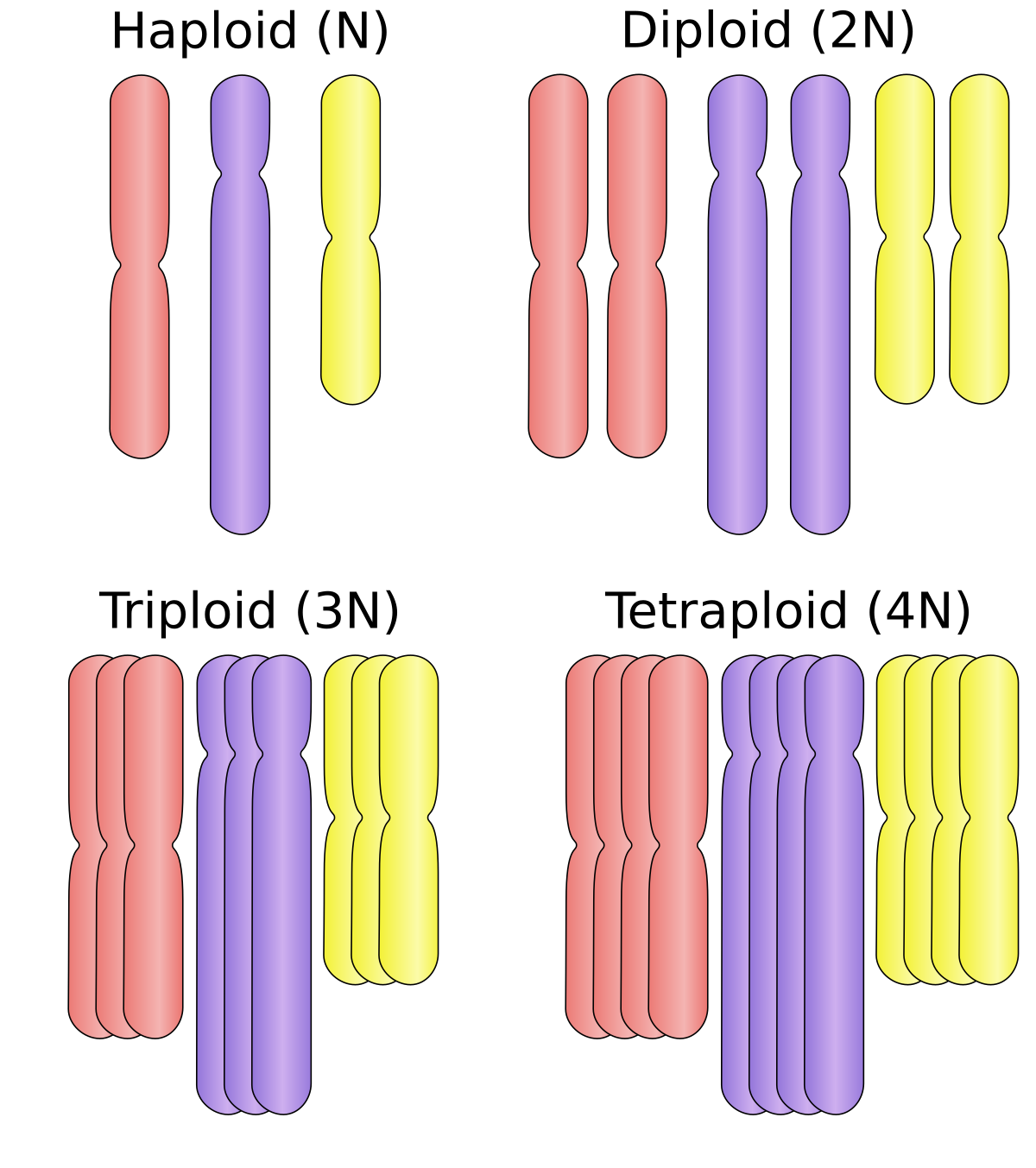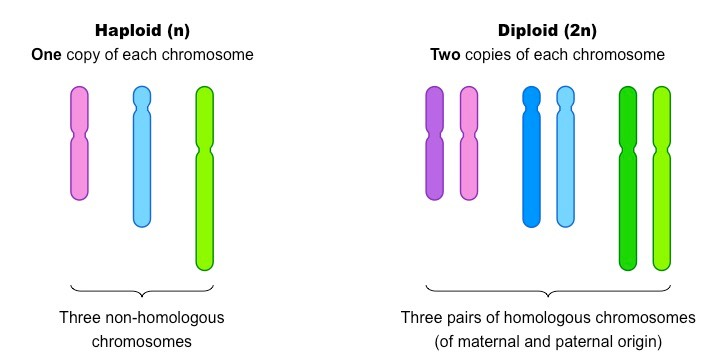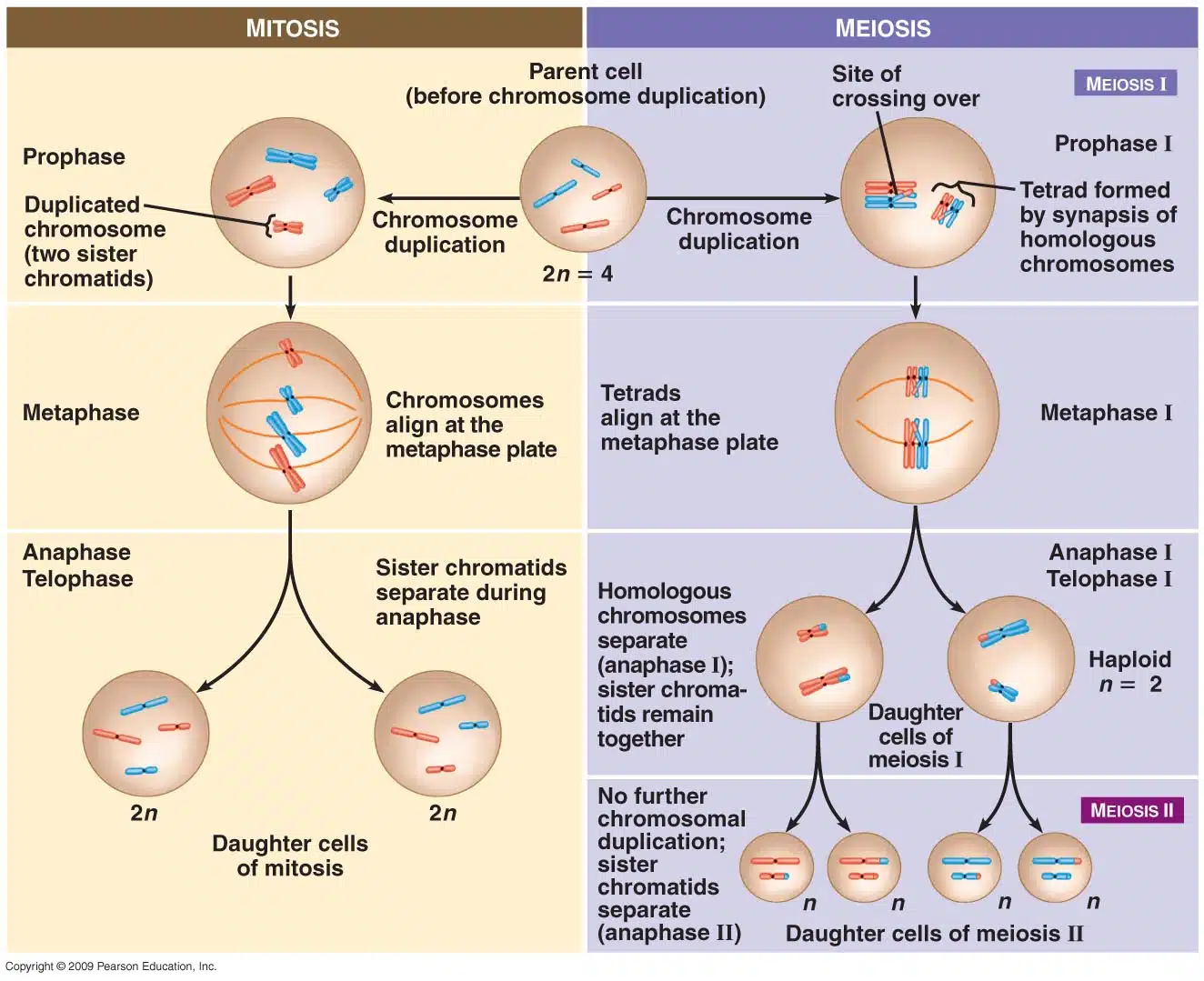16.02 Haploid and Diploid Cells
1. Chromosome Sets in Cells
- Chromosomes are structures within cells that contain DNA, carrying genetic information essential for an organism’s development, functioning, and reproduction. The number of chromosome sets varies between haploid and diploid cells.

a. Diploid Cells (2n)
- Definition: Diploid cells contain two complete sets of chromosomes, totaling twice the number of chromosomes found in haploid cells. Each set originates from one parent.
- Characteristics:
- Chromosome Number: In humans, diploid cells have 46 chromosomes, organized into 23 pairs.
- Homologous Pairs: Each pair consists of homologous chromosomes—one inherited from the mother and one from the father.
- Examples:
- Somatic Cells: Most body cells (e.g., skin cells, liver cells) are diploid.
- Zygotes: The initial cell formed when two gametes fuse during fertilization is diploid.
- Significance:
- Genetic Stability: Maintains consistent chromosome numbers across generations.
- Genetic Variation: Homologous pairs allow for genetic recombination during meiosis, increasing genetic diversity.

b. Haploid Cells (n)
- Definition: Haploid cells possess a single complete set of chromosomes, containing half the number of chromosomes found in diploid cells.
- Characteristics:
- Chromosome Number: In humans, haploid cells have 23 chromosomes.
- Non-Homologous: Each chromosome is unique without pairing.
- Examples:
- Gametes: Sperm and egg cells are haploid.
- Spores: In plants and fungi, spores are haploid cells involved in reproduction.
- Purpose:
- Sexual Reproduction: Ensures that upon fertilization, the resulting zygote restores the diploid chromosome number.
- Genetic Diversity: Facilitates the mixing of genetic material from two parents.
- Variation Across Species:
- Humans: n = 23
- Mosquitoes: n = 3
- Avocados: n = 12
- (Note: The haploid number varies widely among different organisms.)

2. Fertilization and Chromosome Contribution
- Fertilization is the process where two haploid gametes merge to form a diploid zygote. This fusion restores the diploid chromosome number and combines genetic material from both parents.
- Process:
- Gamete Formation: Meiosis reduces the chromosome number by half, producing haploid sperm and egg cells.
- Fusion: During fertilization, one sperm cell fuses with one egg cell.
- Zygote Formation: The resulting zygote is diploid, containing two sets of chromosomes—one from each parent.
- Outcome:
- Chromosome Restoration: The diploid state is re-established, ensuring genetic continuity.
- Genetic Variation: Combines different alleles from each parent, contributing to genetic diversity in offspring.

3. Key Terminology
- Fertilization: The union of two gamete nuclei, resulting in a zygote.
- Zygote: The diploid cell formed by the fusion of two haploid gametes.
- Diploid (2n): Cells containing two sets of chromosomes.
- Haploid (n): Cells containing one set of chromosomes.
- Homologous Chromosomes: Pairs of chromosomes that are similar in shape, size, and gene content, one inherited from each parent.
- Meiosis: The type of cell division that reduces the chromosome number by half, producing haploid gametes.
- Mitosis: The type of cell division that results in two identical diploid cells, used for growth and repair.
4. Cell Cycle and Division
- The maintenance of haploid and diploid states is governed by the cell cycle, specifically through mitosis and meiosis.
a. Mitosis
- Purpose: Facilitates growth, development, and tissue repair by producing identical diploid cells.
- Process:
- Prophase: Chromosomes condense and become visible; the nuclear envelope breaks down.
- Metaphase: Chromosomes align at the cell’s equatorial plate.
- Anaphase: Sister chromatids are pulled apart to opposite poles.
- Telophase: Nuclear envelopes reform around each set of chromosomes.
- Cytokinesis: The cytoplasm divides, resulting in two identical diploid daughter cells.
- Outcome: Maintains chromosome number, ensuring genetic consistency across cells.
b. Meiosis
- Purpose: Produces haploid gametes for sexual reproduction, introducing genetic variability.
- Stages:
- Meiosis I:
- Prophase I: Homologous chromosomes pair and exchange genetic material (crossing over).
- Metaphase I: Homologous pairs align at the equatorial plate.
- Anaphase I: Homologous chromosomes are separated to different poles.
- Telophase I and Cytokinesis: Two haploid cells are formed.
- Meiosis II:
- Prophase II: Chromosomes condense again.
- Metaphase II: Chromosomes align at the equatorial plate.
- Anaphase II: Sister chromatids are separated.
- Telophase II and Cytokinesis: Four genetically distinct haploid cells are produced.
- Meiosis I:
- Outcome: Generates genetic diversity through independent assortment and recombination.

5. Lifecycle
:
- Growth and Development:
- Mitosis: Cells divide by mitosis, increasing the number of diploid cells for growth and tissue maintenance.
- Reproduction:
- Meiosis: Specialized cells undergo meiosis to produce haploid gametes.
- Fertilization:
- Fusion of Gametes: A haploid sperm cell fuses with a haploid egg cell to form a diploid zygote.
- Continuation of Lifecycle:
- Zygote Development: The diploid zygote undergoes mitosis to develop into a multicellular organism, repeating the cycle.

Diagrams:
- Diploid Cells: Represented by paired chromosomes.
- Haploid Cells: Represented by single chromosomes.

- Processes: Mitosis and meiosis cycles illustrating the transitions between diploid and haploid states.

6. Key Differences Between Haploid and Diploid Cells
| Feature | Haploid (n) | Diploid (2n) |
|---|---|---|
| Chromosome Sets | One set of chromosomes | Two sets of chromosomes |
| Cell Types | Gametes (sperm and egg) | Somatic cells (body cells), zygotes |
| Formation Process | Meiosis | Mitosis |
| Function | Sexual reproduction, maintaining chromosome number | Growth, development, tissue repair |
| Genetic Variation | High (due to recombination in meiosis) | Low (cells are genetically identical) |
Practice Questions
Question 1: Define Sexual Reproduction.
Answer: Sexual Reproduction is a biological process that involves the production and fusion of specialized sex cells known as gametes to form a zygote, which subsequently develops into a new organism.
Marking Scheme:
- Definition of Sexual Reproduction (2 marks)
- 1 mark for stating that it is a biological process involving the production and fusion of gametes.
- 1 mark for mentioning that it forms a zygote which develops into a new organism.
Total: 2 Marks
Study Notes: Sexual reproduction combines genetic material from two parents through gametes (sperm and egg), leading to genetic diversity in offspring.
Question 2: List three key characteristics of sexual reproduction and briefly explain each.
Answer:
- Combination of Genetic Material: Involves the merging of genetic information from two parents.
- Genetic Diversity: Promotes variation within a population, enhancing adaptability and evolution.
- Production of Gametes: Specialized sex cells (sperm and egg) are produced through meiosis.
Marking Scheme:
- Three Key Characteristics (3 marks)
- 1 mark for each characteristic listed correctly.
- Explanation of Each Characteristic (3 marks)
- 1 mark for a brief explanation of each characteristic.
Total: 6 Marks
Study Notes:
- Combination of Genetic Material: Ensures offspring inherit traits from both parents.
- Genetic Diversity: Increases the population’s ability to survive changing environments.
- Production of Gametes: Meiosis reduces chromosome number, ensuring genetic variation.
Question 3: Explain the process of meiosis in gamete formation.
Answer: Meiosis is a type of cell division that reduces the chromosome number by half, resulting in haploid gametes. In males, meiosis occurs through spermatogenesis to produce sperm cells. In females, it occurs through oogenesis to produce egg cells. This process involves two successive divisions (Meiosis I and Meiosis II) without an intervening round of DNA replication, ensuring each gamete has half the chromosome number of the parent cell.
Marking Scheme:
- Definition of Meiosis (1 mark)
- Meiosis reduces chromosome number by half to produce haploid gametes.
- Gamete Formation in Males and Females (2 marks)
- 1 mark for spermatogenesis in males producing sperm.
- 1 mark for oogenesis in females producing egg cells.
- Details of the Process (2 marks)
- 1 mark for mentioning Meiosis I and II.
- 1 mark for explaining no DNA replication between divisions, ensuring haploid gametes.
Total: 5 Marks
Study Notes: Meiosis ensures genetic variation through processes like crossing over and independent assortment, which shuffle genetic material during gamete formation.
Question 4: Compare and contrast mitosis and sexual reproduction in terms of genetic variation and chromosome number.
Answer:
- Genetic Variation:
- Mitosis: No genetic variation; produces genetically identical cells.
- Sexual Reproduction: High genetic variation due to recombination and independent assortment during meiosis.
- Chromosome Number:
- Mitosis: Maintains the same chromosome number as the parent cell (diploid).
- Sexual Reproduction: Reduces chromosome number by half in gametes (haploid) through meiosis, which fuse during fertilization to restore diploid number.
Marking Scheme:
- Genetic Variation Comparison (2 marks)
- 1 mark for stating mitosis results in no genetic variation.
- 1 mark for stating sexual reproduction results in high genetic variation.
- Chromosome Number Comparison (2 marks)
- 1 mark for mitosis maintaining diploid number.
- 1 mark for sexual reproduction reducing to haploid and restoring diploid upon fertilization.
Total: 4 Marks
Study Notes: Mitosis is essential for growth and repair, producing identical cells, while sexual reproduction introduces genetic diversity, crucial for evolution and adaptability.
Question 5: Describe the process of fertilisation in sexual reproduction.
Answer: Fertilisation is the merging of two haploid gametes (sperm and egg) to form a diploid zygote. The process involves:
- Recognition and Binding: The sperm recognizes and binds to the egg.
- Penetration: The sperm penetrates the egg’s protective layers.
- Combination of Nuclei: The nuclei of the sperm and egg merge, combining their genetic material to form the zygote.
Marking Scheme:
- Definition of Fertilisation (1 mark)
- Merging of two haploid gametes to form a diploid zygote.
- Steps of Fertilisation (3 marks)
- 1 mark for Recognition and Binding.
- 1 mark for Penetration of egg’s protective layers.
- 1 mark for Combination of nuclei to form zygote.
Total: 4 Marks
Study Notes: Fertilisation restores the diploid chromosome number and initiates the development of a new organism through zygote formation and subsequent cell divisions.
Question 6: Why is genetic diversity important in populations? Provide two reasons.
Answer:
- Adaptability: Genetic diversity enhances a population’s ability to adapt to changing environments, increasing the chances of survival.
- Disease Resistance: Greater genetic variation reduces the likelihood that a disease can affect all individuals, as some may possess resistance.
Marking Scheme:
- First Reason (1 mark)
- Adaptability due to genetic diversity enhancing survival in changing environments.
- Second Reason (1 mark)
- Disease resistance as genetic variation prevents widespread susceptibility.
Total: 2 Marks
Study Notes: Genetic diversity is critical for the resilience of populations, allowing them to withstand environmental pressures and evolve over time.
Question 7: Identify and explain two advantages and two disadvantages of sexual reproduction.
Answer: Advantages:
- Genetic Diversity: Increases variation within a population, enhancing adaptability and evolution.
- Elimination of Harmful Mutations: Recombination can help remove deleterious mutations from the gene pool over generations.
Disadvantages:
- Energy and Time Consumption: Sexual reproduction requires more energy and time compared to asexual reproduction.
- Dependency on Two Parents: Relies on the successful union of two gametes, which may not always occur, reducing reproductive success.
Marking Scheme:
- Advantages (2 marks)
- 1 mark for Genetic Diversity with explanation.
- 1 mark for Elimination of Harmful Mutations with explanation.
- Disadvantages (2 marks)
- 1 mark for Energy and Time Consumption with explanation.
- 1 mark for Dependency on Two Parents with explanation.
Total: 4 Marks
Study Notes: While sexual reproduction fosters genetic variation and helps maintain healthy populations by eliminating harmful genes, it is more resource-intensive and less efficient in producing offspring compared to asexual methods.
Question 8: Match the following key terms with their correct definitions.
| Terms | Definitions |
|---|---|
| 1. Gamete | A. The diploid cell formed by the fusion of two gametes |
| 2. Zygote | B. A haploid sex cell involved in sexual reproduction |
| 3. Meiosis | C. Cell division that produces haploid gametes |
| 4. Genetic Diversity | D. Variation in genetic characteristics within a population |
Answer:
- Gamete – B. A haploid sex cell involved in sexual reproduction
- Zygote – A. The diploid cell formed by the fusion of two gametes
- Meiosis – C. Cell division that produces haploid gametes
- Genetic Diversity – D. Variation in genetic characteristics within a population
Marking Scheme:
- Each correct match (1 mark each)
- 4 terms × 1 mark = 4 marks.
- Incorrect matches receive no marks.
Total: 4 Marks
Study Notes: Understanding key terms is essential for grasping the concepts of sexual reproduction and its implications for genetic variation and inheritance.
Question 9: Explain how sexual reproduction can lead to the elimination of harmful mutations from a population.
Answer: Sexual reproduction involves genetic recombination during meiosis, which can separate harmful mutations from beneficial or neutral genes. When gametes fuse during fertilisation, harmful mutations may be masked by healthy alleles from the other parent. Over successive generations, harmful mutations are less likely to be passed on, as they are eliminated through natural selection, ensuring that individuals with fewer deleterious mutations have higher survival and reproductive success.
Marking Scheme:
- Genetic Recombination (1 mark)
- Recombination during meiosis can separate harmful mutations from other genes.
- Masking of Mutations (1 mark)
- Harmful mutations may be masked by healthy alleles during fertilisation.
- Natural Selection (1 mark)
- Individuals with fewer harmful mutations are more likely to survive and reproduce.
Total: 3 Marks
Study Notes: Sexual reproduction facilitates the removal of harmful genetic variations, contributing to the overall health and viability of populations.
Question 10: Describe the development of a zygote into a multicellular organism.
Answer: After fertilisation, the zygote, which is the initial diploid cell, begins to undergo repeated mitotic divisions in a process called cleavage. These mitotic divisions increase the number of cells without increasing the overall size of the organism. As cell division continues, the cells begin to differentiate, meaning they develop into various types of cells that form different tissues and organs. This growth and differentiation lead to the formation of a multicellular organism, with specialized structures performing specific functions necessary for survival.
Marking Scheme:
- Initial Cell – Zygote (1 mark)
- Zygote is the first cell of the new organism.
- Mitosis (1 mark)
- Repeated mitotic divisions increase the number of cells.
- Growth and Differentiation (2 marks)
- Cells differentiate into various tissues and organs.
- Formation of a multicellular organism with specialized structures.
Total: 4 Marks
Study Notes: The development from a zygote to a multicellular organism involves cell division and differentiation, ensuring that the organism grows and forms the necessary structures for life.
Summary of Key Points:
- Sexual Reproduction: Fusion of gametes (sperm and egg) to form a zygote.
- Gametes: Haploid cells produced via meiosis; sperm in males and eggs in females.
- Meiosis: Reduces chromosome number by half, introduces genetic variation.
- Genetic Diversity: Essential for adaptability, evolution, and disease resistance.
- Fertilisation: Merging of sperm and egg, forming a diploid zygote.
- Mitosis vs. Sexual Reproduction: Mitosis produces identical cells for growth/repair; sexual reproduction creates genetic diversity.
- Advantages of Sexual Reproduction: Genetic diversity, elimination of harmful mutations.
- Disadvantages of Sexual Reproduction: Requires more energy and time, dependency on two parents.